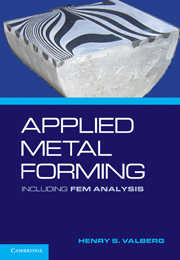Book contents
- Frontmatter
- Contents
- Preface
- APPLIED METAL FORMING
- 1 Characteristics of Metal Forming
- 2 Important Metal Forming Processes
- 3 FEA of Metal Forming
- 4 Theory
- 5 Reduction and Proportions of the Plastic Zone
- 6 Deformations from the Velocity Field
- 7 Technological Tests and Physical Simulation
- 8 Flow Stress Data
- 9 Formability and Workability
- 10 Friction and Friction Models
- 11 Thermal Effects
- 12 Experimental Metal Flow Analysis
- 13 Theoretical Methods of Analysis
- 14 Finite Element Analysis
- 15 FEA of Technological Tests
- 16 Forging
- 17 FEA of Forging
- 18 Extrusion
- 19 FEA of Extrusion
- 20 Rolling
- 21 FEA of Rolling
- 22 Drawing of Wire, Profiles, and Tubes
- 23 FEA of Wiredrawing
- 24 Sheet-Metal Forming
- Index
22 - Drawing of Wire, Profiles, and Tubes
Published online by Cambridge University Press: 05 June 2012
- Frontmatter
- Contents
- Preface
- APPLIED METAL FORMING
- 1 Characteristics of Metal Forming
- 2 Important Metal Forming Processes
- 3 FEA of Metal Forming
- 4 Theory
- 5 Reduction and Proportions of the Plastic Zone
- 6 Deformations from the Velocity Field
- 7 Technological Tests and Physical Simulation
- 8 Flow Stress Data
- 9 Formability and Workability
- 10 Friction and Friction Models
- 11 Thermal Effects
- 12 Experimental Metal Flow Analysis
- 13 Theoretical Methods of Analysis
- 14 Finite Element Analysis
- 15 FEA of Technological Tests
- 16 Forging
- 17 FEA of Forging
- 18 Extrusion
- 19 FEA of Extrusion
- 20 Rolling
- 21 FEA of Rolling
- 22 Drawing of Wire, Profiles, and Tubes
- 23 FEA of Wiredrawing
- 24 Sheet-Metal Forming
- Index
Summary
Wiredrawing was described briefly in Ch. 2.2.6 as a metal forming process in which a wire is reduced in thickness by pulling it through a drawing die shaped as a conical channel. It was also mentioned that drawing can be performed for profiled cross sections also, not only round ones. In addition to this, hollow products like tubes can be manufactured by drawing.
Drawing processes are attractive in that they are cold forming processes, use a stiff die with rather small reduction. Because of this, the forming load on the die is small. Therefore, the dimensional stability is better than if the product were made by alternative processes, like extrusion or rolling. To improve the dimensional accuracy of the cross section of rolled or extruded products, they are sometimes given a final calibration draw before final use.
In this chapter, various practical aspects of wiredrawing will first be considered. It will be shown how a thin wire is manufactured by drawing down a thick wire in many steps in a drawing machine. Typical dies used in order to reduce the diameter of the wire will then be described.
It was early figured out that the drawing force is an important parameter in drawing, because higher friction contributes to increase in the required drawing force. A methodology was therefore developed, that allowed friction to be measured directly, using a longitudinally split drawing die. The measuring principle used for this purpose will be described.
- Type
- Chapter
- Information
- Applied Metal FormingIncluding FEM Analysis, pp. 395 - 413Publisher: Cambridge University PressPrint publication year: 2010



